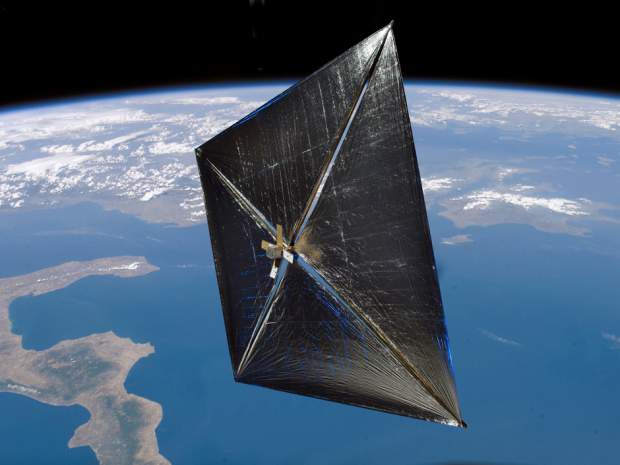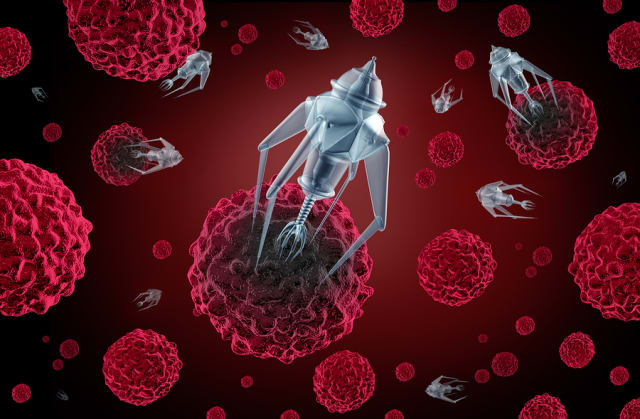Meghan Brown posted on October 15, 2018

Whatever you find most interesting, the constant is that nanotechnology is one of our favorite sci-fi technologies. What’s even cooler is that, like many technologies, nanotech is quickly becoming more “science” and less “fiction.” While we’re not at the point of humanoid replicators or self-assembling vehicles just yet, there are a lot of potential application for nanotechnology to improve some of the most ambitious human endeavours—such as space exploration.
Technology at the Nanoscale
What is nanotech exactly? Short answer, it’s technology that operates at the nanoscale. One nanometer (nm) is measured at one billionth (10-9) of a meter, and the convention is to assign the term “nanotechnology” to technology that operates on the scale of 1 to 100 nm. The 1 nm bottom limit is due to the size of atoms, which nanotech needs to manipulate, while the upper limit is largely arbitrary as the size where nanoscale phenomena become apparent and useable by a nano device.Nanotechnology features two primary approaches, which are “bottom up” where materials or devices are self-assembled from molecular components, and “top down” where nanoscale objects are constructed by micro-scale and macro-scale devices. Both methods show potential for the development of future nanomaterials and nanodevices capable of exhibiting specific properties or being programmed to perform tasks and operate autonomously.
With the potential inherent in nanotechnology, it’s easy to see why nanoengineering and nanotechnology research are booming, and a particular focus is on exploring space: how to get there, how to protect space travellers, and where they will live when they arrive on distant planets.
Nanotechnology for Space Exploration
Space exploration is a prime candidate to take advantage of nanotechnology. It’s expensive and risky, and in many ways currently, extremely inefficient. Picture the millions spent on space missions, the satellites and astronauts lost, and the sheet investment of time needed for even the simplest endeavor.
(Image source: Forbes.com)
Propulsion
Propulsion is one of the most significant challenges to developing fast and convenient space travel. Make no mistake, we’ve gotten pretty good at building rockets that go really fast—even fast enough to get into orbit around the planet—but that’s when things slow right down. While launch rockets are great at what they were designed to do (lift a giant tube away from the planet), they aren’t meant for the slower speed and fuel longevity required for extended travel. Once a spacecraft wants to leave orbit and journey somewhere else, a different kind of propulsion engine is required.Solar sails could be the solution, and are one of the technologies that sees a lot of potential in nanotechnology. As a propulsion device, solar sails use the pressure of solar radiation against a highly reflective expanse of material to create thrust, and therefore don't need additional propellant fuel. However, solar sails do need to have a very large surface area that is extremely reflective, but also extremely thin and lightweight.

The
Solar Sail Demonstration mission led by NASA and L’Garde Inc. aimed to
prove the viability of using ultra thin sails and sunlight for
propulsion. (Image courtesy of NASA.)
There’s also the goal of developing future nanotechnology and nanomaterials that will have self-repairing properties. In the context of solar sails, this could be invaluable; for example, if the nanomaterial could recognize and repair damage sustained during deployment and travel, such as tears during the unfolding process, or “healing” from micrometeorite impacts. This could drastically improve the success and longevity of these missions, enabling solar sail-propelled spacecraft to travel faster and farther.
Planetary Exploration with Nanobots and Nanosensors
Exploring the surface of a distant planet using swarms of tiny nanorobots is another popular application of nanotech in space.Currently, the Mars rovers—Spirit, Opportunity and Curiosity—have been the greatest success stories when it comes to planetary exploration. But as scientifically rich as these missions have been, each rover can only examine one small area at a time, and their movement speeds are quite slow. It’s understandable, given the time lags involved in communicating between Earth and Mars, and the complexity of the instructions and data that must be relayed back and forth.
Understandable, but extremely slow.

Low-angle
self-portrait of NASA’s Curiosity Mars rover. Taken August 5th, 2015,
the image is a composite showing the vehicle and the site where it
performed drilling operations, dubbed “Buckskin” on lower Mount Sharpe.
Future planetary exploration using nanobots would replace these types
of rovers, and provide faster and more detailed mapping, chemical
analysis, atmospheric composition and other vital data. (Image courtesy
of NASA.)
With the development of nanobots that operate using some form of artificial intelligence (AI) that enables them to communicate and self-organize, then the possibilities are almost limitless. A planetary surface survey mission could see nanobots rolling or crawling across the landscape, collecting sensor data on the minerals and compounds in the air and ground, testing for toxicity or measuring radiation, and then assembling into a communication antenna to transmit the data back to a hub station or satellite for further analysis and relay back to Earth.
A team from Northeastern University engaged in investigating possible concepts for nanotech in space exploration also proposed the idea of a sensor net “spider web” comprised of hairline tubes that could be deployed to spread across large areas of a planet’s surface. The tubes would contain a multitude of nanosensors to measure surface temperature, chemical composition and other elements of the planetary environment.
Nanobot swarms could also be effective in exploring the thick atmosphere of planets like Venus, or the stormy gaseous planets such as Jupiter and Saturn, by releasing nanobots or nanosensors into the atmosphere and having them transmit their data back to orbiting satellites, gathering detailed information on wind currents, storm patterns, and chemical composition of these planets.
For these applications of nanorobotics, many researchers are looking to nano electromechanical systems (NEMS) in the place of conventional motor designs. This is because NEMS can be made of nanomaterials, such as carbon nanotubes, these roots can be made extremely tiny, and extremely flexible.
NEMS are a specific class of device that integrates electrical and mechanical functionality at the nanoscale, and combine transistor-like nanoelectronics with mechanical components such as motors, pumps and actuators. They are often used as physical, biological or chemical sensors for a variety of applications, such as accelerometer and air chemical sensors.
Nanomaterials for Enhanced Spacesuits
But travelling to other planets, and exploring them with nanobots, is only half the journey – eventually, humans will want to travel to these planets, and explore the surface for themselves.Spacesuits enhanced with nanotechnology will be an essential aspect of getting humans safely to other planets, and enabling them to spend time exploring—since, as of yet, there are no planetary surfaces discovered (other than Earth, of course) which have breathable atmosphere, and radiation during space travel and on an extraterrestrial planet’s surface is a constant concern.

Spacesuits made from nanomaterials will be lighter and more flexible, allowing astronauts to explore and maneuver easily.
At it’s most basic—relatively speaking, since this is still advanced futuristic tech—a spacesuit could have a gel or metallic nanomaterial layer between the interior and exterior surfaces of a spacesuit. This layer would respond to a puncture or tear by reorganizing or reassembling in order to close or repair the damage. Those interior and exterior layers are also likely to be fabricated out of advanced metamaterials that have been nanoengineered for exceptional strength and durability, while remaining thin and lightweight—which would make the space suits resistant to damage right from the start.
With thinner materials, those spacesuits would also be much more flexible, making it easier for astronauts to move through the spaceship or planetary environment to explore and perform scientific tasks.
Along with repairing damage to the suits, there are nanotech applications that would monitor and repair the astronaut inside. Of course, the word “repair” is used a little loosely; what’s referred to would be the medical monitoring and treatment capabilities that nanotech could make available.
Space travel and space exploration are extremely dangerous to humans, no two ways about it, and even the most advanced protective efforts could still fail or be damaged. This means it’s also vital to be able to monitor astronauts’ health and vitals, as well as be able to administer a variety of treatments effectively and on demand.

Artist’s conception of nanorobots that can enter the human body and treat disease or deliver medication at the cellular level.
These sensors would be able to relay the data to the astronaut via a heads-up display (HUD) in their space suit, or back to the main base or ship system, ensuring real-time response to any health issues. Nanosensors could also communicate with nano-implants or other medical devices within the astronaut’s body to deliver drugs, vitamins or emergency medicine as needed, ensuring the astronaut will be in peak condition while performing their tasks.
In an extreme case, such as sustaining an injury through or beneath the suit (like Watney in The Martian), many researchers envision something like a nanogel that will recognize there is an injury and have the ability to self-organize to seal the wound, supply antibiotics, and otherwise provide enough treatment that the astronaut will have time to return to the ship or base to receive proper medical care.
Nanotechnology-Built Habitats
Once the travel, exploration and personal gear are covered, what’s left is where these astronauts will stay once they arrive on a new planet.Colonization of other planets is a long-standing human dream, and our technological capabilities are finally approaching the sophistication necessary to accomplish this goal—just look at NASA’s Mars 2020 plan.
Habitat construction for planetary colonization will greatly benefit from the use of nanotech in several ways, the most significant of which will be with building structure for humans to work and live.
3D printing is a popular proposal for creating habitat spaces and is a large-scale example of what sufficiently advanced nanotech could do at the much smaller scale. Current technologies envision essentially an oversized 3D printer that can “print” a building out of cement-like mixtures mined and processed from surface materials.

Houses
designed by Zopherus as part of NASA’s Habitat Centennial Challenge,
which would be 3D printed and deposited by the roving lander, pictured
at right. (Image courtesy of NASA.)
Ideally, these nanobots would be programmed ahead of time with instructions for those tasks and the design of the habitat, then they would act collectively and autonomously to complete the project. This could be much more efficient than a single large printer extruding material to build, and would enable a far greater ability to custom-design habitat buildings for the needs of the astronauts and the environmental factors unique to a given planetary surface. Transporting the necessary equipment would also be easier, since all a habitat-building mission would need is a lander full of nanobots, rather than trying to launch and land heavy equipment.
However, it’s still possible that the giant 3D printer will be the way to go—at least in the beginning—but that doesn’t mean nanotech won’t still be useful. Particularly nanomaterials, as the building material being derived from the planet’s surface could still be augmented by nanotech to be stronger, lighter, and more resistant to radiation or toxicity.
Another method of building habitable spaces on a planet is to create tunnels beneath the surface, which would provide some degree of natural protection from radiation or a toxic atmosphere. Nanotech would be useful in this scenario, as well, with nanobots able to dig the tunnels, and turn these minerals into a strong nanomaterial to then line the tunnel walls and build other structures beneath the surface.
Aside from buildings, extra-terrestrial colonies will also need reliable communication, both with other colonization groups on the planet’s surface and with orbiting communications satellites or space ships. Just as self-assembling, AI-enabled nanobots would organize themselves into communications equipment and antennas during the planetary exploration phase, they would be able to continue this function for an established colony.
Potential Dangers
Overall, nanotech and nanorobotics look extremely promising for applications in space exploration and colonization—but a rosy outlook by no means guarantees a problem-free outcome.Popularized by K. Eric Drexler in his 1986 book Engines of Creation, the “grey goo” scenario—an idea that nano-scale assemblers capable of fabricating any object, as well as self-replicating, could run amok and consume everything in their path—is often what first comes to mind when people consider the ways nanotechnology could go wrong. But this really is largely science fiction.
The more realistic risks to nanotechnology are similar to the risk factors inherent in any new technology or chemical compound. For example, while the idea of nanobots used to heal wounds is appealing, there is still no way of knowing just what the effect would be on the human physiology. Currently there is a trend toward using nanoparticles in consumer products—for example, cosmetics and skin care products—we are also seeing evidence that these nanoparticles can cause skin and organ damage with repeated exposure. Nanotechnology for healthcare and medical treatment is still in it’s infancy, and as yet there’s no way to know whether there will be long term effects from introducing foreign nanoparticles or nanorobotics into the human body.
There is also the risk of environmental contamination, a particular concern when exploring previously untouched extraterrestrial planetary surfaces. Current missions to explore the moon, Mars or asteroids far out in the solar system are meticulous about ensuring that no biological contaminants are on the equipment, landers or rovers that will be coming into contact with these distant environments.
However, many of the nanotechnology solutions to surveying these environments involve releasing nanoscale sensors or robotics into the air and onto the ground. There is a realistic expectation with these swarms that not only would it be virtually impossible to reclaim every last one of them, but the presence of these foreign objects could contaminate or otherwise have an adverse effect on the environment.
